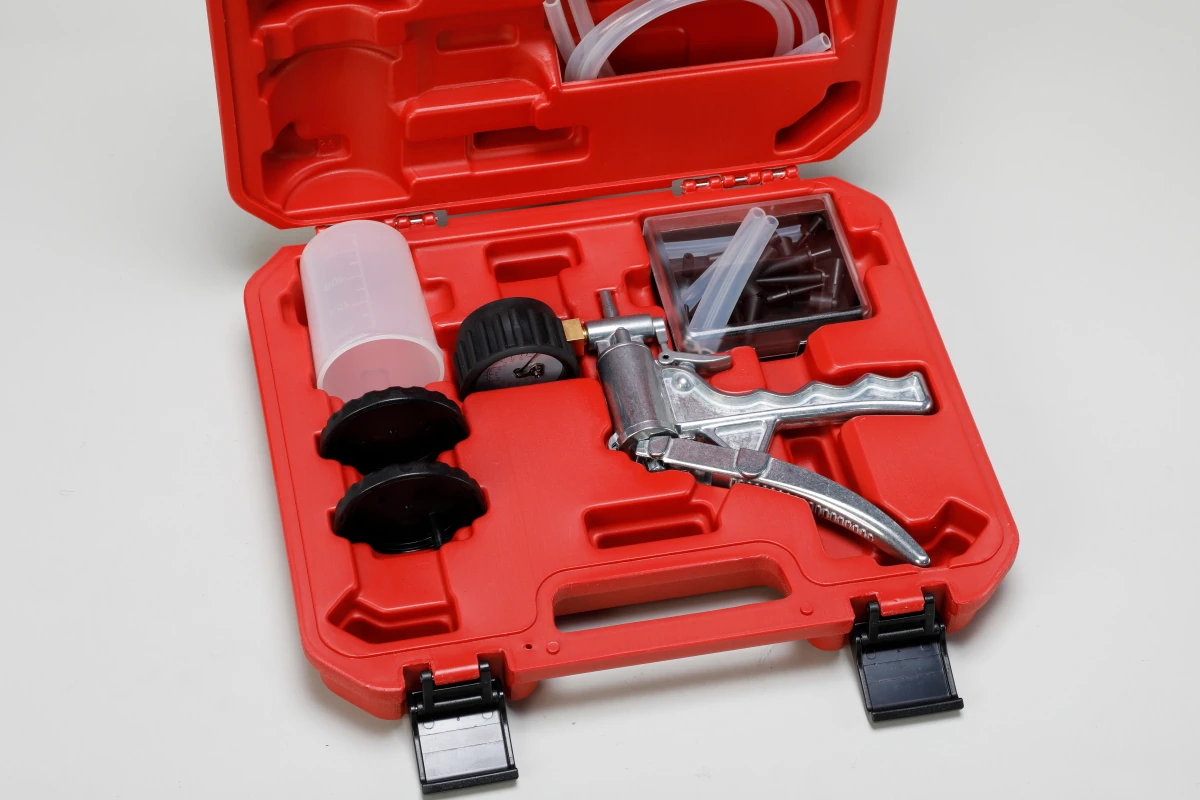Stopping performance is absolutely more important for a motorcycle than running performance.
To achieve this, brake maintenance is indispensable, but if you do not have the knowledge or experience, it is wise to ask a professional to do it for you. On the other hand, there are a number of items that can improve work efficiency when focusing on tools.
Here we introduce some tools that are useful for brake maintenance, especially brake fluid replacement.
- Fluid change every two years, an essential part of disc brake maintenance
- Manual vacuum pump that can replace fluid without mixing air
Fluid change every two years, an essential part of disc brake maintenance


Brake fluid deteriorates due to heat generated during braking and moisture in the air. Periodic replacement is essential because moisture not only lowers the boiling point but also causes caliper piston seals to deteriorate and pistons to rust. When replacing fluid without removing the piston from the caliper, it is common to drain the fluid from the master cylinder through the bleeder plug.
The components of disc brakes include brake calipers, rotors, brake hoses, and master cylinders, but perhaps the most important component is the brake fluid. There are several methods for improving brake performance and customization, such as converting to low-expansion type brake hoses or calipers with a higher number of pistons. But no matter what means are used, the brakes will not function without the final injection of brake fluid. As we have repeated many times in the past, brake fluid degrades over time and performance decreases. Glycol-based fluids such as DOT3 and DOT4 have hygroscopic properties that allow them to easily take in moisture from the air. Thanks to this, any moisture that gets into the brake system will dissolve into the fluid, and the heat generated during braking will not boil off the moisture alone, even if the temperature exceeds 100°C.
However, even DOT4 fluid, which has a boiling point of over 230°C when new, will drop to over 155°C when moisture absorption is reduced to just under 4%. Although the fluid temperature will not rise to an extreme level unless the car is braked hard, as in track riding, the only way to restore the performance that has been degraded by moisture contamination is to replace the fluid. Therefore, as a general rule, it is recommended to change the fluid at least once every two years, but if there are many opportunities for riding in the rain, such as commuting or touring, once a year is also acceptable. On the other hand, brake fluid that has absorbed moisture can deteriorate the rubber seals of the master cylinder and calipers and cause rust on the caliper pistons.
Manual vacuum pump that can replace fluid without mixing air


An example of a vacuum tester & brake bleeding kit using a manual vacuum pump. This set of tools includes a pump that generates negative pressure by lever operation, a silicone hose with various adapters, and a cup for fluid. It can be used to check hydraulic brake fluid, bleed air, and inspect the diaphragm of a negative-pressure fuel cock.


When the components are set up like this and the pump lever is operated, the hose and cup become negative pressure, and fluid in the caliper is sucked out. Since the flow is more continuous than operating the brake lever by hand, check the remaining amount in the master cylinder frequently. Even if the master cylinder is empty, if you fill it with fluid and hold the pump, air and fluid will be sucked out together.
The most important thing when replacing brake fluid is to prevent air from getting into the fluid or to ensure that any air that does get into the fluid is drained out. The brake lever or brake pedal operation is transmitted from the master cylinder to the calipers using brake fluid as the hydraulic fluid. Brake fluid, being a liquid, does not change in volume when pressure is applied to it in the master cylinder, but if air gets mixed in, it is used to crush it.
This makes the lever and pedal feel spongy and ineffective! If there is no air in the path before replacing the fluid, it is a sure way to add new fluid to the master cylinder while draining the fluid from the bleeder plugs of the brake calipers. A manual vacuum pump is recommended for efficient fluid replacement. A manual vacuum pump also called a “Mighty Vac” or “Vacuum Tester,” consists mainly of a pump that generates negative pressure by holding a lever.
By installing a special cup between the bleeder plug and the pump, the fluid drained by applying negative pressure is stored, and if the same amount of new fluid is injected into the master cylinder, air will not be mixed in.
Although the fluid can be drained by loosening the bleeder plug and operating the brake lever or brake pedal, it must be stroked several times to replace the entire amount.
Also, if you hold the lever with the master cylinder reserve tank cap open, fluid may spurt out and splash. Using a manual vacuum pump allows the fluid to drain continuously, so no fountain occurs in the reserve tank, but be aware that the fluid may drain too smoothly and the reservoir tank may be empty when you notice it. Even if the fluid in the path is empty after the caliper or master cylinder overhaul, a negative pressure pump allows continuous suction, so it can be reliably filled with less effort than repeated lever or pedal pumping. Another tool that uses negative pressure is a vacuum pump that can be continuously suctioned by connecting air from an air compressor.